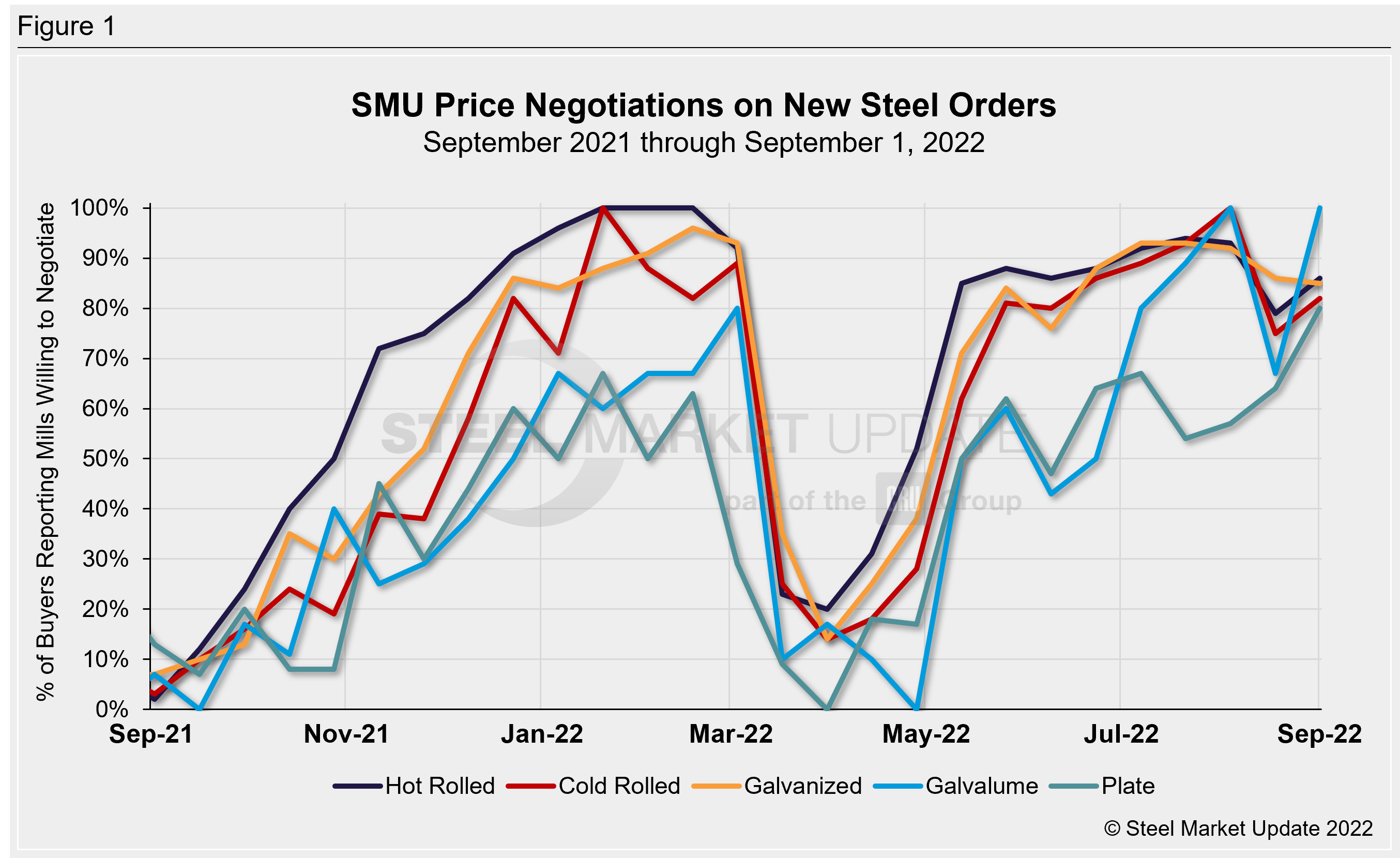SMU Data and Models

Steel Mill Negotiations: Willingness to Talk Price Remains High
Written by Brett Linton
September 1, 2022
After contracting in mid-August, the percentage of buyers reporting that mills’ prices are negotiable grew this week. All but 15% of the steel executives polled this week reported that mills are willing to talk price to secure an order, according to our steel market surveys. A high willingness to negotiate has been evident in each of our checks since early May.
SMU polls hundreds of steel buyers every other week with the question: Are you finding domestic mills are willing to negotiate spot pricing on new orders? On average this week, 85% of steel buyers reported that mills were willing to negotiate lower prices on new orders. This rate is up from 77% in mid-August, but down compared to the 88-89% rates seen in July and early August. Recall we saw negotiation rates as low as 16% in March.
As one buyer commented, “Folks are still very, very hungry for real tons.” Another remarked, “The band is smaller than it was, but there is still room from where they start”
Broken down by product, 86% of hot rolled buyers surveyed are now responding that mills are willing to negotiate lower prices, up from 79% two weeks prior. Negotiation rates were in the 92–94% range for the three prior surveys.
For cold rolled, 82% of buyers polled reported that mills were willing to bargain, up from a 75% rate two weeks ago. 85% of galvanized buyers reported that mill prices are negotiable, relatively unchanged from two weeks prior, and down from the 92–93% rates seen in recent months.
Galvalume negotiation rates tend to be more volatile due to the smaller market size, with 100% of respondents reporting mills are negotiable this week, up from a 67% rate in early August.
Negotiations have been slightly less common in the plate market but have been rising since mid-July. 80% of buyers reported a willingness to negotiate this week, up from 64% two weeks prior and 57% one month ago. Plate negotiation rates had been between 54–67% for nearly two months prior. Recall we saw plate negotiation rates of 0–18% in March and April.
SMU’s Price Momentum Indicator was adjusted from Lower to Neutral on Aug. 9 and will remain there until the market establishes a clear direction.

Note: SMU surveys active steel buyers twice each month to gauge the willingness of their steel suppliers to negotiate pricing. The results reflect current steel demand and changing spot pricing trends. SMU provides our members with a number of ways to interact with current and historical data. To see an interactive history of our Steel Mill Negotiations data, visit our website here.
By Brett Linton, Brett@SteelMarketUpdate.com

Brett Linton
Read more from Brett LintonLatest in SMU Data and Models

SMU Steel Survey: Sentiment Indices dip as buyer optimism softens
SMU’s Buyers’ Sentiment Indices experienced multi-point declines this week, though both remain positive and continue to reflect optimism among steel buyers for their companies' ability to be successful.

SMU Scrap Survey: Current Buyers’ Sentiment flat, Future Sentiment tumbles
SMU's Current Scrap Buyers' Sentiment Index remained flat this month, while the Future Sentiment Index declined.

SMU Survey: Steel mill lead times show diverging trends
Buyers responding to our latest market survey reported that sheet lead times continue to gradually decline from recent highs. Meanwhile, plate lead times increased to levels last seen one year ago.

SMU Survey: Mills unlikely to budge on price, buyers say
Four out of every five steel buyers who responded to our latest market survey say domestic mills are unwilling to negotiate on new order spot pricing. Mills have shown little flexibility on pricing for nearly two months.

SMU’s March at a glance
SMU’s Monthly Review provides a summary of our key steel market metrics for the previous month, with the latest data updated through March 31.
